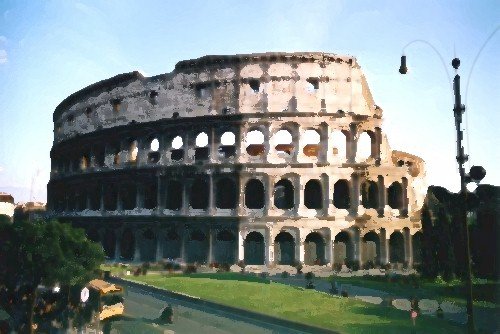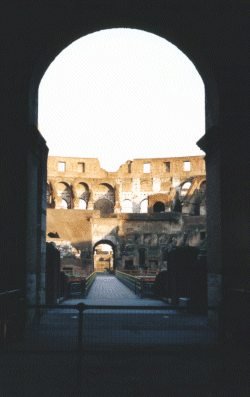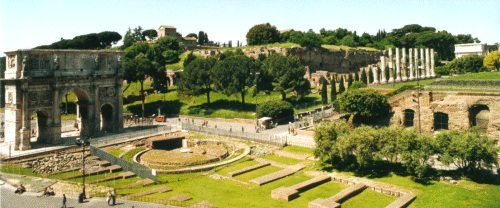
The recent restoration works on the Colosseum (from: https://www.todsgroup.com/en/sustainability/colosseum)
(photographs by A. Pepe)
Tod’s Group is supporting the restoration of the Colosseum, the renowned symbol of Italian history.
The “intervention plan” for the restoration of the Flavian amphitheatre is a project requested by the government commissioner for Rome’s archaeological areas and Ancient Ostia in collaboration with the Special Superintendent for the Colosseum and the Rome’s Archaeological Heritage and supported by Tod’s.
The first part of the intervention plan is completed with the restoration of the northern and southern prospectus (approximately 13,300 square meters), and the replacement of the actual locking system of arches with new gates.
The plan foresees the restoration of the ambulatory and basements of the Colosseum, the retrofit compliance and implementation of standard equipment and the creation and repositioning from internal to an external visitors’ service and reception area.
Tod’s Group is proud to have participated in the restoration of the Colosseum, giving this internationally renowned monument back to the world, an iconic symbol of both Roman and Italian history.
The restoration of the Colosseum is an initiative that was developed by the Commissioner of the Archaeological area of Rome and Ostia Antica in agreement with Rome’s Archaeological Heritage Department.
Tod’s for Colosseum
The second phase of the project, which began in December 2018 under the supervision of the new autonomous institute Parco Archeologico del Colosseo, has focused on the Colosseum’s hypogea, a monument within the monument, corresponding to the portion of the amphitheatre which lies below the arena and that in ancient times was invisible to the spectators.
The restoration saw the involvement of more than 80 people, including archaeologists, restorers, architects, engineers, surveyors and construction workers.

At the end of the works, a 160 metre long walkway was installed in the Colosseum, opening up to visitors an area of the monument that had never been accessible before.
The research activities that took place during the restoration process allowed for a better understanding of the mechanisms used by technological devices dating back to the Flavian Age (69-96 AD). At the time, a system of elevators allowed men, animals and props to be brought to the arena. Today, 24 mobile platforms and 28 wooden elevators can still be seen.

Rome Colosseum Being Restored for Wider Public Viewing
Deutsche Presse-Agentur
June 29, 2001
ROME, Italy—Emperor Titus Vespasianus Augustus ruled Rome for just two years, yet his short-lived government changed the city’s landscape forever.
Having succeeded his father Vespasian in 79 A.D., the former commander of the Praetorian Guard enjoyed unexpected popularity.
A good-looking and cultivated 39-year-old, Titus gave generously to the victims of Pompeii, he built the Arco di Tito to commemorate his capture of Jerusalem, and even found time to construct public baths.
But above all, he was to be remembered as the man who inaugurated the Flavian amphitheater in 80 A.D., with lavish celebrations lasting more than 100 days and nights. Some 5,000 animals were said to have been slaughtered for the occasion. Nearly 2,000 years of wars, earthquakes, vandalism, and general wear-and-tear have reduced what was once the glory of the empire into a ruin. Now it is up to architect Giangiacomo Martines to return Rome’s Colosseum to the people. He is in charge of a major U.S. $18-million-dollar restoration project, the biggest since 1836.
As well as providing valuable funds for crucial research into the largest standing building from the ancient world, the project aims to expand the amount of space open to tourists.

Preservation and Expanded Use
When restoration started, in 1995, just 15 percent of the Colosseum was open to visitors. Martines hopes that by the time the project is completed, in 2003, as much as 85 percent will be visible to the public. “Keeping an old monument closed to visitors is like locking a vintage car in a museum—it may be nice to look at, but if you try to start its engine, it won’t work,” said Martines.
According to Martines, the more the Colosseum is opened up to visitors, the better preserved it will be for the future. “Tourists are good for the Colosseum. They keep it in working order,” he said. Visitors can only be grateful to Martines’ uncommon approach to conservation, which initially lifted more than one eyebrow among his colleagues. Last year, as many as 2.5 million people toured the world’s most famous amphitheater, making it by far Italy’s most visited site. No doubt fostered by Ridley Scott’s blockbuster movie Gladiator, that trend is on the rise, with the figure having already reached 1.6 million in the first half of this year, according to unofficial data from Italy’s Culture Ministry.
Steady Progress
At this time, visitors can explore only the amphitheater’s ground and the first floor. But the restoration project has already brought about some important improvements. For instance, a wooden path now crosses the arena, allowing a better view of the chambers and dungeons where exotic animals and slaves were once kept before fighting. Last summer, a newly built wooden platform positioned at one end of the path was used to stage Greek melodrama.
This month, a gladiator exhibition was inaugurated on the second level, in an area previously closed to the public. Featuring 150 exhibits, including armor, weapons, and helmets found during the excavation of a gladiator barrack at Pompeii, the “Blood and Arena” exhibition will continue until the end of the year.
The sponsorship money made available by a large Italian bank has also allowed archaeologists to dig up and study new areas, such as a private passage built by Emperor Comodus, the villain of the Gladiator movie. The passage, which is six meters underground, connected the imperial box inside the Colosseum with an unknown point outside. Experts believe it was probably used as an imperial emergency exit.
Someday, Martines said, visitors may even be allowed access to the Colosseum’s uppermost story, which offers a breathtaking 180-degree view of the eternal city. “It’s all about keeping it in working order,” he said.
(c) 2001 Deutsche Presse-Agentur
